![]()
![]()
![]()
![]()
![]()
![]()
![]()
a Comenius project web site
MYTHICAL CREATURES
IN NORWEGIAN FOLKBELIEF
COMENIUS
PROJECT II - KIRKEBYGDEN SKOLE
VÅLER IN NORWAY 2001/2002
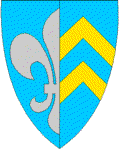

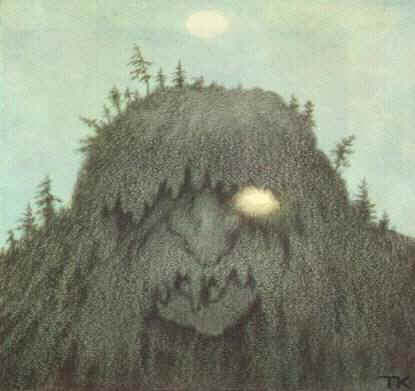
In Norway we have defined mythical creatures as the ones we find in fairytales and legends,
not the ancient Norse gods of the Vikings. In our country these creatures
have played an important part in daily life of peasants and country people
up to as late as the last part of the nineteenth century. But also
the urban population believed in the abilities of ghosts and the
importance of performing protectional rites in connection with seasonal
work, life passages, etc.
The landscape and the economic bases
of our long country differs greatly from the North to the South,
from the East to the West. You will find sea monsters and creatures
connected to sea and fishing along the coast, forest gnomes and lake
creatures in the southern and
mid-Norwegian inland and the special Sami traditions in the northernmost
parts. We have tried to describe the creatures you meet in our video plus
some “extras”, but we assure you: There are many more!
The creatures are mostly described in present term; that doesn’t mean that these beliefs are parts of Norwegian life and culture today!
NØKK (river
sprite)
This
creature is also a water being, but it’s found in lakes and rivers –
not in the sea. It can turn up as a handsome young man playing the fiddle
or the harp so beautifully that people go into the water without
recognising that they can’t swim, and then they drown.
Other times he shows himself as a white horse, walking invitingly
near the river- or lakeside, but if you try to ride this horse, he will
jump directly to the bottom of the water with you. He can also be seen as
a ghastly head with glowing eyes, easily taken for a small island with red
lights. Guess what happens if you try to enter the ”island”!
Traditions
all over the country, but mostly found in the forest areas and
agricultural districts of Eastern Norway
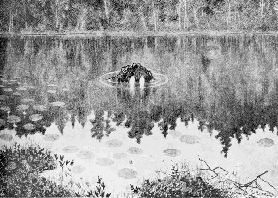
DRAUG (sea monster, ghost of the
sea)
A
skeleton dressed in oilskins and sou’wester, sailing in a halfboat. If
fishermen or sailors see him, they know that they’re almost certain to
drown. Some times he’ll go ashore and try the thwarts in newly built
boats. People sitting on a thwart where the draug has been seated are
bound to drown. Before the ship goes down, the halfboat will turn up and
sail along with the ship and lead it into dangerous waters.
Most
traditions found in Northern Norway.
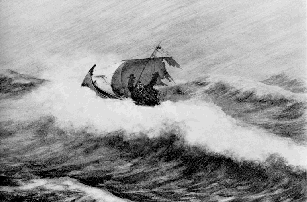
TUSSER (goblins)
These
are small beings living under the ground, and they can do damage to people
who don’t clean their stables or cow-stalls properly, or if you
unawarely trample on their “roofs” when walking in the woods. They
will try to get revenge by claiming to marry “the prettiest girl on the
farm” or go up in the mountains to lonely dairy farms and threaten the
dairymaid to marry them. If the girl does so, they promise her family
prosperity and silver and wellfed herds of cattle. If not, she will die an
ugly maiden and her family will die in poverty. Tusser are old, ugly and
look as a mixture of bones, moss and twigs. They are not easily seen, but
you can hear them titter maliciously!
Traditions
all over the country.
HULDER (wood nymph)
The
hulder (huldra) belongs to the underground people. She is a beautiful
young girl with long blonde (or dark) hair, walking around in the woods,
trying to seduce young men and lure them to marry her and move under
ground with her. She is often seen herding cattle - cows which are
exceptionally fat and full of milk, and the leader cow has a bucket with
little silver bells on its horns. She is dressed in a national costume or
a white blouse and a skirt, and her chest is decorated with silver and
gold. But you recognise that she’s a hulder if she turns her back to you:
She has a cow’s tail!
Traditions
found mostly in forest areas and agricultural districts.
TROLL
Probably the best known
creature from Norwegian fairytales and folk traditions. Trolls in wood,
textile, plastic, etc., etc. has
been important souvenirs for more than fifty years. Our trolls can have
more than one head (up to 12!), just one single eye in the middle of its
forehead and it’s HUGE! To show how big it is,
it is sometimes drawn with trees growing on
Traditions
found all over the country.
NB!Something all these creatures have in common: They are scared away by the cross or other Christian items, and if you throw steel after them ( a knife, a piece of a knife or the likes) they will disappear.
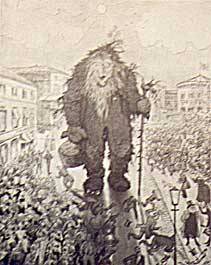
CREATURES
YOU FIND IN MOST OF THE COUNTRY (but
don’t meet in the video):
NISSEN (the fogey)
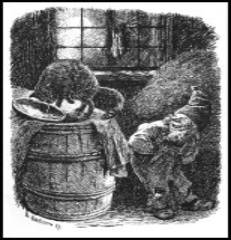 Nissen is a small man dressed in grey clothes and with a red stocking cap
on his head. He’s got only four fingers; the thumb is lacking.He usually
stays in the barn or the stables where he is tending to the cattle, making
sure that they are well treated. If the people on the farm mistreat their
animals he will punish them severely. He can make himself invisible and
beat them till they’re blue all over, or he can make you stumble and
spill your milk or fall into the manure heap. But if you are nice to the
animals, he will help you in every way. And you must ALWAYS remember to
put out a bowl of porridge in the barn for him on Christmas Eve!
Nissen is a small man dressed in grey clothes and with a red stocking cap
on his head. He’s got only four fingers; the thumb is lacking.He usually
stays in the barn or the stables where he is tending to the cattle, making
sure that they are well treated. If the people on the farm mistreat their
animals he will punish them severely. He can make himself invisible and
beat them till they’re blue all over, or he can make you stumble and
spill your milk or fall into the manure heap. But if you are nice to the
animals, he will help you in every way. And you must ALWAYS remember to
put out a bowl of porridge in the barn for him on Christmas Eve!
NB!During
the last 75 – 100 years our nisse has been assimilated with Santa Claus,
so in Norway it’s “nissen” who comes with the gifts at Christmas.
UTBURDEN (the out-carried child)
Utburden
is a child that the mother has born secretly and isn’t able to keep. She
kills it and buries it somewhere or just leaves it in the woods to be
killed by wild animals. This child will haunt its mother until she
confesses her crime or let some remains of it be buried within the
churchyard. Sometimes the child walks around crying, naked and miserable,
and if anybody hears or see it they can try this formula:
Eg døyper deg på ei von,
anten Kari eller Jon
(I baptise you at random, either Kari or Jon)
Then
the child will find peace.
BYTTINGEN (the changeling)
If
people got a child with a handicap or a child that screamed a lot , they
would believe that the underground people had taken their child and
changed it with one of their own. To make them take the child back and
give you your own child you could
-
treat the changeling so badly that the underground mother came to
get her baby
-
try to baptise it
-
smear soil from a grave on the child’s forehead
etc.
“Bytting” is still used as a term of abuse to people you disgust!
STALLO
(the sami wizard)
The
Sami traditions up North differ a bit from other parts of Norwegian
traditions. You will find troll and draug and some other creatures as well,
but the Stallo is purely Sami. He can change into all kinds of beings,;
animals, human beings, plants, insects, bird – anything. He can also
“turn” the landscape so you miss your direction or change it so you
don’t recognise familiar surroundings. Stallo is very rich and smart, he
owns silver and reindeers galore, but he always wants more. To get what he
wants he tries to trick the Samis into traps, and the most popular Sami
stories tell how people manage to fool Stallo.
NB! Don’t mix Stallo with the noaide! He is a real wizard
who people still believe in!
Norway April-2002